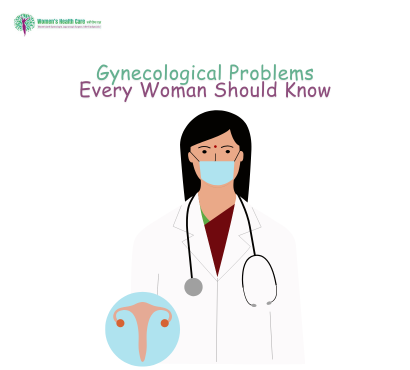1. Why Awareness Matters
Gynecological health significantly influences a woman’s physical, emotional, and social wellbeing. Many conditions—PCOS, menstrual disorders, infections—are often misunderstood, stigmatized, or overlooked. Raising awareness empowers timely care, preventing complications like infertility or chronic pain. Open dialogue starts with recognizing and addressing common issues.
2. Irregular Periods: When “Normal” Isn’t Clear
What It Means
A normal menstrual cycle ranges from 21 to 35 days. Irregular periods include:
- Skipped or missed cycles
- Heavy or unusually light flow
- Cycles shorter than 21 days or longer than 35
Common Causes
- Hormonal shifts (adolescence, perimenopause)
- PCOS imbalance
- Stress or rapid weight changes
- Thyroid abnormalities
- Uterine fibroids or polyps
Red Flags
- Very heavy flow (soaking >1 pad/hour)
- Bleeding after menopause or between cycles
- Persistent irregularities affecting daily life
Self-Care Tips
- Track cycles with apps or journals
- Maintain balanced diet and weight
- Manage stress with yoga, mindfulness
- Exercise moderately to support hormonal balance
3. PCOS (Polycystic Ovary Syndrome)
Symptoms
- Irregular periods or skipped cycles
- Excess facial/body hair (hirsutism)
- Acne or oily skin
- Weight gain, especially around the abdomen
- Small ovarian cysts seen in scans
Why It Happens
Insulin resistance stimulates excess androgens, disrupting ovulation and causing cyst formation.
Health Impacts
- Infertility or delayed conception
- Higher risk of diabetes, heart disease
- Sleep apnea and liver issues (NAFLD)
Management
- Balanced, low-GI diet to regulate insulin
- Physical activity: brisk walking, strength training
- Stress reduction techniques
- Medications as prescribed by professionals
4. Urinary & Vaginal Infections
A. Bacterial Vaginosis (BV) & Yeast Infections
Yeast Infections
- Thick white discharge with itching
- Worsens after antibiotics or in hot, humid climates
BV
- Thin, greyish discharge with fishy odor
- Often associated with unprotected sex or wiping habits
B. Urinary Tract Infections (UTIs)
- Burning sensation during urination
- Sudden urge to urinate with minimal output
- Lower abdominal pain
Prevention
- Wipe front-to-back
- Change wet clothes promptly
- Stay hydrated
- Avoid scented feminine products
5. Uterine Fibroids & Endometriosis
A. Uterine Fibroids
- Non-cancerous muscle growths in the uterus
- Symptoms: heavy bleeding, pelvic pain, pressure on bladder/bowels
B. Endometriosis
- Tissue resembling uterine lining grows outside the uterus
- Causes severe cramps, painful intercourse, infertility
Self-Awareness
- Track symptoms: heavy flow, pelvic pain, painful sex
- Acknowledge when menstrual pain is more than “just cramps”
6. Pelvic Pain & Prolapse Issues
Chronic Pelvic Pain
- Lasts >6 months
- May be caused by pelvic inflammatory disease (PID), scarring, or adhesions
Pelvic Organ Prolapse
- Uterus, bladder, or rectum descends into the vaginal canal
- Symptoms: heaviness, urinary or bowel trouble, sexual discomfort
Self-Management
- Pelvic floor strengthening (Kegels, pelvic physiotherapy)
- Avoid heavy lifting
- Maintain healthy weight
7. Cycle-Related Anemia & Iron Deficiency
Heavy bleeding or prolonged periods can deplete iron stores, leading to fatigue, pallor, and dizziness.
Self-Support
- Eat iron-rich foods (spinach, pulses, lean meat)
- Pair with vitamin C for better absorption
- Periods exceeding 7 days warrant medical attention
8. Breast Self-Exams & Awareness
While not strictly gynecological, breast health is linked to reproductive hormones.
How to Examine
- Monthly self-checks in the shower or in front of a mirror
- Feel for lumps or asymmetry
- Report any unusual signs like nipple discharge or skin puckering
9. When to Seek Medical Guidance
Any of the following warrant professional evaluation:
- Heavy flow impairing daily life
- Sudden unexplained pelvic or abdominal pain
- Suspected infections
- Issues with fertility or recurring cycles
- Suspected prolapse symptoms
Early action ensures better outcomes.
10. Self-Care Routine: A Week in the Life
| Day | Action |
| Any | Drink 2–3 L water • Practice pelvic floor exercises |
| Menses | Track flow and mood • Replenish iron nutrients |
| Weekly | Check for unusual discharge or odor |
| Monthly | Perform breast self-exam • Note menstrual changes |
| Occasionally | Practice yoga/stretching for pelvic health |
Understanding your body is the first act of empowerment. By recognizing common gynecological issues—from irregular cycles to pelvic pain—you build confidence to take charge and seek help early. A gentle habit of tracking cycles, practicing pelvic awareness, and paying attention to warning signs fosters not only physical health, but emotional resilience too.
FAQs
Q1. How do I know if my periods are unusually heavy?
Fufilling a pad or tampon every 1–2 hours or passing clots larger than a quarter suggests heavy bleeding—talk to a healthcare provider.
Q2. Can PCOS be reversed naturally?
Lifestyle changes—balanced diet, regular exercise, stress management—can significantly improve or reverse PCOS symptoms over time.
Q3. Do yeast infections need medication?
Mild infections may respond to over-the-counter treatments, but recurrent or severe cases warrant a check-up for confirmation and tailored care.

